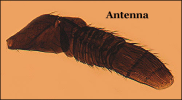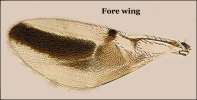Scientific name
Comperiella indica Ayyar
Taxonomic position
Hymenoptera: Chalcidoidea: Encyrtidae: Encyrtinae
Diagnosis
Body elongate, dorsoventrally somewhat flattened. Head with dark dorsal median longitudinal band on frontovertex around ocelli, narrower than the pair of lateral white bands. Mesosoma (thorax) dark metallic blue; pronotum with a pair of white bands interrupted in the middle; mesoscutum with
a median, longitudinal, metallic greenish-blue band. Antenna (Fig. 1) short, compact, scape flattened
and expanded beneath, more or less triangular with the anterolateral margin about 0.25x the rest of dorsal margin, and 0.5x of dorsal length of pedicel; flagellar segments strongly flattened and transverse. Fore wing (Fig. 2) infuscate, with a complete, longitudinal, median dark band reaching up to apex and a second, smaller, triangular patch placed below the median band. Ovipositor subequal in length to mid tibia, not exserted apically. Live specimens are characterised by the wing tips which are folded upwards as the insect moves around in search of its host as reported by Prinsloo (1984).
 Fig. 1. Antenna Fig. 1. Antenna
 Fig. 2. Fore wing Fig. 2. Fore wing
Images
Distribution
India: Karnataka; Tamil Nadu; Uttar Pradesh.
Hosts
Coccus viridis (Green); Octaspidiotus tamarindi (Green) (=Aspidiotus
tamarindus Ayyar) (Ramakrishna Ayyar, 1934).
References
- Hayat, M. 2006. Indian Encyrtidae (Hymenoptera: Chalcidoidea). Department of Zoology, Aligarh Muslim University, Aligarh. 496 p.
- Prinsloo, G.L. 1984. An illustrated guide to the parasitic wasps associated with citrus pests in the Republic of South Africa. Science Bulletin, Department of Agriculture, Republic of South Africa, 402: 1-119.
- Ramakrishna Ayyar, T.V. 1934. First record of the chalcid genus Comperiella Howard from India with description of a new species. Records of the Indian Museum, 36: 219-221.
|